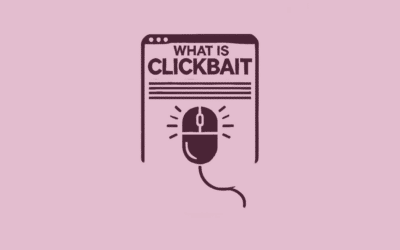No URL exists in a vacuum.
Instead, every stop a user makes on the internet is joined through a vast interconnection of links, allowing them to move easily from one web address to another as they define their own path. This interrelation between disparate pages, sites, and computers is what defines the internet. It’s right there in the terminology: Internet. Network. World Wide Web — each one references a fundamental aspect of modern digital communication. Namely, that it’s all linked.
And that’s exactly how Google likes it.
When determining which pages should rank for any specific keyword, the Google search algorithm (and other search algorithms) consider multiple factors. — everything from site structure and mobile accessibility to page loading speed. But one of the most relevant components is backlinks. What kinds of pages are referencing and linking to your site? And what can those links tell Google about the quality and expertise of your pages?
Link Building: Spinning a Web of Authority
Link building is an approach to SEO that places these connections front and center, allowing site owners such as yourself to take a more intentional approach by working with partners to create links between sites.
Of course, if you landed on this page because you were searching ‘link building,’ you probably already understand the concept. Suffice it to say that by building a backlink profile made up of inbound links from authoritative sites you signal to Google that your site is likewise worthy of attention. The connected sites share their domain authority (DA), and the search algorithm acknowledges that association by giving your site a boost in the SERP. Simple, right?
Well, no. Not usually.
Because even if you master the process of building backlinks, there’s still something that matters more to Google than whom you know (and who’s willing to admit that they know you). And that’s the content on your page.
Why Is Content So Important?
Google has gone through a lot of algorithm updates in the past decade (and further back), always refining its approach to vetting, classifying, and ranking web pages for more accurate search results. But while each update brings something new to the table, most of them share a singular objective: To ensure that top-quality content gets priority in the SERP (this is especially true when we consider Google’s Helpful Content Update that was rolled out in August).
It makes sense. After all, Google exists to make profit, usually through search ads. But most Google users don’t hop into the search engine because they want to be advertised to; they use Google because it’s a free service that connects them to information online. When a user types in a search query, they’re looking for a solution to some kind of problem. And if the results Google provides aren’t the cream of the crop, then those users aren’t going to stick around to encounter ads or otherwise make use of Google’s services.
In other words, Google wants to find the top content to meet its users’ needs. Their leading position in the search-engine world (and by extension their ability to generate revenue) depends on it. That’s why outdated black-hat SEO tricks no longer work; if you try to game the system by stuffing in a thousand keywords or spinning someone else’s work as your own, you’re going up against the best detection software an $1148 billion company can deploy.
As such, the continuing trend in SEO is towards quality, and it probably always will be. High-quality content is virtually bulletproof, weathering Google algorithm updates that have a tendency to obliterate lower-quality pieces that are built on perceived loopholes and shortcuts.
What Does This All Have to Do With Backlinks?
Content is king… but that doesn’t mean it’s the only member of the royal court. There’s a school of thought that says that when you create great content you don’t have to put as much effort into building your backlink profile (like the Field of Dreams, the idea here is that “If you build it, [the links] will come”). But this still leaves a lot to chance. After all, even if your content is top-notch, how are other high-quality sites going to find and reference it if you don’t have the backlinks to back it up?
This of course begs the question: How can you become visible enough to attract links and readers if you need links and readers to become visible? The answer is to put aside the whole chicken/egg debate and bake backlinks and quality into your pages right from the start.
Start With the Data
Quality will always be the most defining factor in SEO. But here’s the catch: It can be next to impossible to create high-quality content without access to relevant, reliable, recent data. This is because the quality of the content depends on its ability to solve users’ problems. Good-quality content must educate, inspire, encourage, and/or entertain. Data gives you the insights you need to understand what your visitors want from your content so you can meet their expectations.
Good data breeds great quality. SERP data, when properly applied, provides a clearer picture of who your audience is, what they want to know, and how your top competitors are approaching the same problems. You can then use these insights to more directly target their needs as you ideate and create new content… or revisit and optimize your existing content for improved usability.
But that’s only step one. Now you need to let Google know that your content is worth highlighting. That means rubbing virtual elbows with other top domains via the right kinds of backlinks.
Back It up with Backlinks
Backlinks apply the idea of ‘guilty by association’ to the world of SEO. When search engines crawl your page, they’re looking for (among other things) evidence that your content is good enough that other respected sites are willing to link to it.
Now, it’s worth noting that in the world of SEO backlinking, quantity is not the same as quality. The lawless days of link farming are long gone. Google doesn’t want to see an overstuffed profile filled with inbound links from unrelated, low-quality sites; if that’s what you’ve got, be prepared to see your effort get buried in the SERP (and maybe penalized for good measure).
On the other hand, backlinks from sites that are relevant to your topic and audience and that carry a high DA make Google sit up and take notice.
Just be aware: Much like writing quality content, there’s an art to creating a powerful backlink profile. The domains you connect with (more accurately, the domains that choose to connect with you) should have substantial SEO metrics. After all, how Google ranks them will have an impact on how Google ranks you.
At the same time, the text they use to link to your site needs to show a bit of variety. Exact-match anchor text (hyper-linked text that includes the exact word-for-word term or phrase that you want your page to rank for) is a great way to indicate to Google that your page is relevant to the SERP — after all, the text that links back to you is the keyword.
Just don’t overdo it; too many exact-match links can look suspicious, and Google may doc your rankings if your inbound links are too accurate to be true. Instead, cut those pure links with some non-exact-match anchor text that relates to (but is still distinct from) your keyword.
Today, Google is extremely wary of exact-match links, so keep things nice and innocent by allowing non-exact matches to make up 90–95% of your backlink profile. The remaining 5–10% exact-match links will still help you signal your connection to the keyword without setting off any alarms. Click here to read more about the best ratio of exact-match and non-exact-match links in link building.
A fresh round of exact and non-exact backlinks from high DA sites relevant to your audience supports and reinforces the high-quality content you create. Or, to look at it from the other end: You won’t have much luck if you focus all of your energy on building backlinks and forget to provide anything of substance to link to.
Sound complicated? It certainly can be. As I said, building a powerful backlink profile is an art. So how can you bring the right artists on board to help make it happen?
Backlink Artists and Content Experts Unite
The interplay between content creation and link building is complex, demanding extensive SEO experience and comprehensive data analysis. Luckily, it’s not something you have to manage on your own. BASE Search Marketing provides complete SEO/Backlink solutions — from expert SERP analysis and content creation to unmatched link-building effectiveness. With BASE, you have everything you need to connect with the audiences and sites that will take your business further.
Ready to go? Contact BASE Search Marketing today, and let’s start climbing those SERPs!



